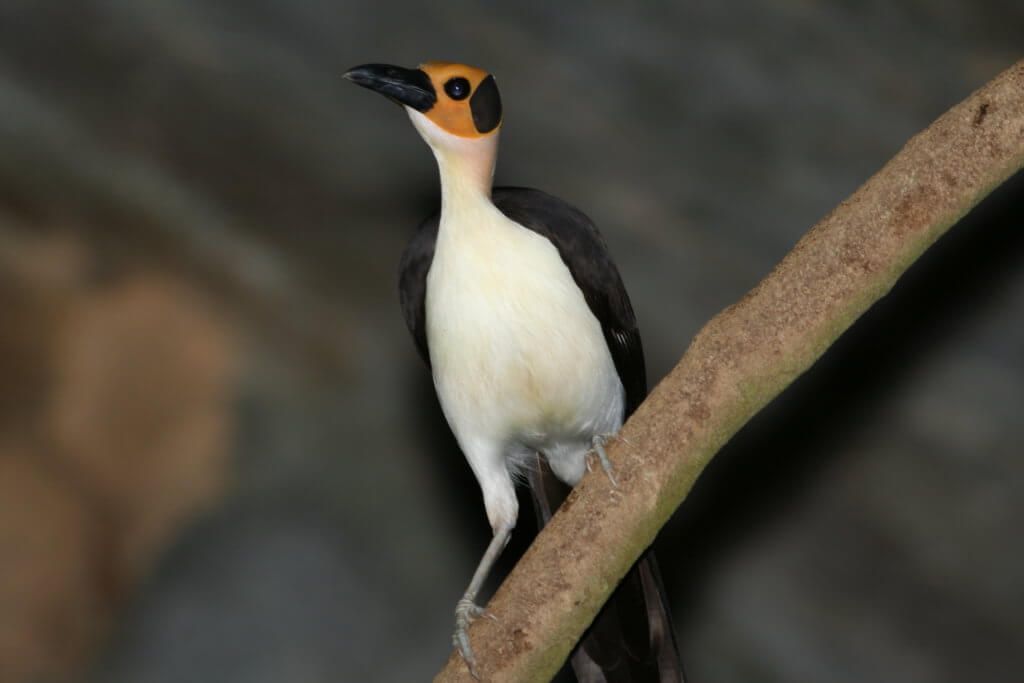
Back in 2006 I had the opportunity to do an RSPB sabbatical colleagues to assist with some bird surveys in the Gola rainforest in Sierra Leone, West Africa. This is the largest remnant of Upper Guinean Tropical Rainforest left in Sierra Leone. It covers nearly 700 square kilometres with more than 330 bird species, plus mammals like the elusive pygmy hippo and chimpanzees. Our BirdLife partners, The Conservation Society of Sierra Leone, looked after us very well and helped arrange the long hikes and portage of equipment between remote forest settlements.
I was very lucky to visit a couple of breeding sites of one of the world’s more remarkable and charismatic birds – the white-necked picathartes. This jungle dwelling bird builds a mud nest under overhanging rocky outcrops. From a small village near the Liberian border, a young boy led me up the hill through the forest to a rocky outcrop. I settled quietly in the undergrowth and was treated to several birds at close quarters, bouncing around the forest and rocks on their ‘spring-loaded’ legs. I had only just bought my first digital camera and confess I probably wasn’t yet fully up to speed but did manage to get some reasonable images.
Other than Sierra Leone it only occurs in Côte d’Ivoire, Ghana, Guinea and Liberia. Worryingly, it appears to be declining in most countries and is threatened throughout its range primarily by commercial logging. The forest is disappearing rapidly, leading to further fragmentation and rapid decline of remaining populations. The majority of breeding colonies are extremely small and isolated, and many are close to the minimum for long-term viability. It is classified as ‘Vulnerable’ by the IUCN.
In Sierra Leone, the prospects appear a little better following some inspiring work to protect the forests. The RSPB first became involved in work in Gola over 20-years ago with a biodiversity survey. This indicated the importance and unique value of this site but also highlighted the threats it faced. A partnership between RSPB, the Forestry Division of the Government of Sierra Leone and The Conservation Society of Sierra Leone was developed to manage the site for conservation. This has become another of RSPB’s amazing international projects alongside habitat protection work in Indonesia and Kazakhstan and efforts to protect endangered species like Asian vultures and albatrosses.
Following a study in 2008, it was concluded that the development of a ‘Reducing Emission from Deforestation and Degradation’ (REDD) was a viable source of funds. The aim of a REDD+ project is to help reduce the impacts of global climate change by protecting the forest to prevent the release of stored carbon and also deliver benefits for biodiversity and local people. In 2011, a major milestone was achieved when the Gola Rainforest National Park (GRNP) was established. This was the second National Park in Sierra Leone and the REDD+ project in Sierra Leone and indeed in West Africa.
As well as protecting the park by teams of rangers, the GRNP invests in local community development. This is based on benefit sharing agreements which are essentially compensation payments to the landowners of the forest. These payments have allowed communities to build core infrastructure such as hospitals and schools and purchase essentially technology. Cocoa farming is also developing to provide sustainable livelihoods.
Encouragingly, in September 2016, the Government of Liberia passed a Bill officially designating 88,000 hectares of Liberia’s rainforest as the Gola Forest National Park. Together with the GRNP this creates the largest single block of the remaining Upper Guinea Forest. Hopefully, this ongoing initiative will continue to provide a permanent home for local people, plus the picathartes and other wildlife of this special place.
Image taken with Canon 350D with a Canon 400mm f5.6 L lens at 1/125, f5.6, ISO 100 and flash.
[registration_form]
“I had only just bought my first digital camera and confess I probably wasn’t yet fully up to speed but did manage to get some reasonable images.”
I’d say it’s a great image Guy and it certainly doesn’t give away your inexperience with the camera!
As for the work to protect the Gola Forest and its biodiversity – including the Picathartes – I for one am very glad to be contributing to it through my RSPB subscription.